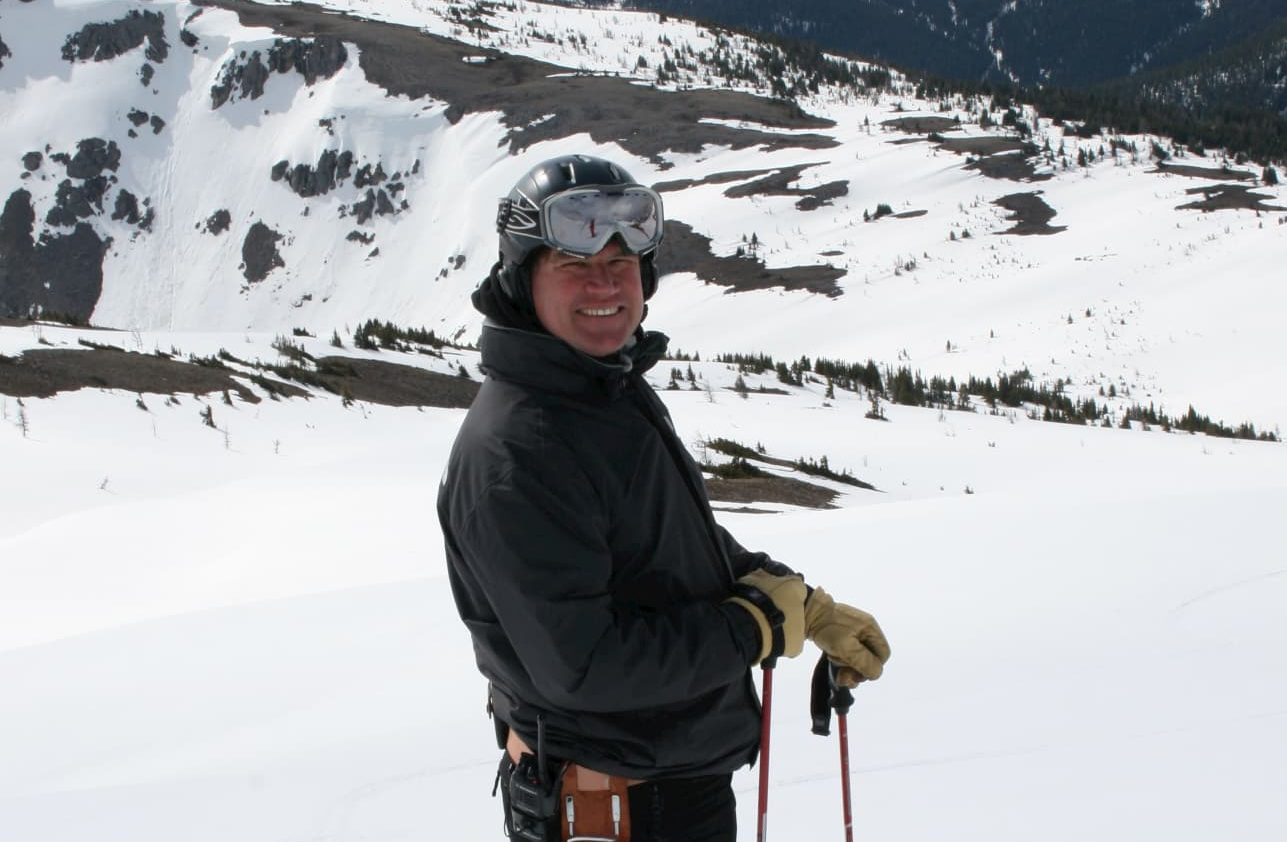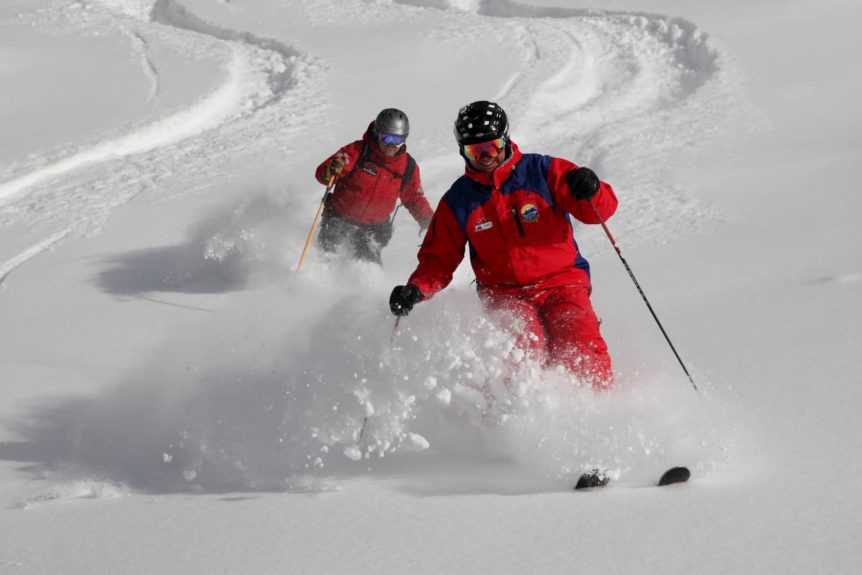NOT YET VISITED A SKI RESORT?
DON’T SWEAT IT: HERE ARE 10 TOP TIPS FOR FIRST-TIMERS, FROM AN EXPERT
So, you’ve heard about all the fun and thrills that comes from a visit to the ski hill and want to give it a go yourself. You have the gear ready. You’ve checked out the details of your local ski area. You’ve set the date. You’re ready for your skiing (or snowboarding) debut – but still don’t know exactly where to begin, or what to expect when you arrive.
We get it: it can seem there’s lots to figure out before getting your start in snow sports, but we’ll let you into a secret: it’s really not as hard as you think! In fact, with a little planning and following of some simple pointers, you’ll be cruising down those runs in no time!
And once you’ve got the hang of it, they’ll be no stopping you; skiing or snowboarding is one of the most fun (and rewarding) ways to spend an Albertan winter – and there’s always new ways to challenge yourself, whether that’s taking on a different run, or tackling a new area of your local ski resort.
Here, we speak to Stewart Laver, Director of Snow Sports at Banff’s Sunshine Village resort, about how you can go from first-timer to confident run-glider in just a few easy steps. With over forty years’ experience in snow sport instruction, Stewart is a total pro when it comes to getting people out on skis (or a board) and breaking out onto the slopes for the very first time.
1. Make a plan
First things first: know before you go! Stewart’s advice is to take advantage of the know-how and resort expertise of your local ski area team. “There’s lots of information for your arrival and how to navigate the resort online, but never be afraid to call your local resort and ask questions,” says Stewart. “They can tell you how to collect your tickets, how to find your way to the chair, pick up your rentals – really anything. They’re there to help.”
2. Grab a good breakfast!
“It’s important to get a good start to the day when you’re heading out on the hill,” Stewart advises. “You’ll need a full tummy, so you’re not getting hungry while you’re out on the mountain – this will set you up to go have fun on the runs.” Stewart also recommends getting a good rest the night before. “Especially if you’re a newer skier and are practicing your ski or snowboard technique, you’ll want to have a focused mind and lots of energy to go and make the most of your day!”
3. Get familiar with the basics; know the alpine responsibility code
If it’s your first time skiing or snowboarding, it’s important to have a handle on the skier code of conduct; familiarize yourself with the ‘alpine responsibility code’ to keep you and other skiers & snowboarders safe. Understanding skier right of way, what’s marked out of bounds terrain, what to do in case of emergency, and how to read trail signs, are the basics that all skiers and boarders (big and small) should know. “Make it your mantra”, says Stewart. “As well as the alpine responsibility code, make use of the resort trail map too – so you can always be sure to find your way confidently from the gondola or chairlift, right down to the base. Remember there’s always an easy way down – the trail map can be your best friend when first getting started at the hill,” Stewart says.
4. Take a private lesson
With twenty five years leading Sunshine’s Snow School under his belt, Stewart knows only too well what a lesson, or snow school program, can do for a skier or boarder’s skill on the slopes – as well as their resort knowledge and confidence level. “I’m such an advocate for spending valuable time with a professional instructor, especially if you’re at the beginner stage,” says Stewart. “An instructor will show you so much more than how to plant your ski pole; we can guide you on the technical practice of snow sports, show you personalized pointers on how to practice your form and flair, and also get you fully comfortable with how to properly use the gear and get kitted out (even to what ski socks to wear). We’ll also help you find your way around the mountain and link the runs to your ability level.” Stewart admits that it can be difficult to figure out how to maneuver on skis or a snowboard by yourself. “That’s where an instructor – especially on a one-on-one basis – can really help get you off to a fantastic start. Consider it a worthy investment; you’ll progress much quicker, will have the best pointers from a professional, and your confidence will be given a huge boost right from the start,” he says.
GO SKI ALBERTA EXTRA TIP: Take a browse of your local ski area’s snow school options for private lessons this season, most ski areas will all have plenty of info to hand on private lessons and programs!
5. Ask a snow host
“Don’t be shy, as there’s no such thing as a stupid question when you’re on the mountain,” says Stewart. He continues: “Here at Sunshine, our snow hosts are trained to help all skiers and snowboarders, especially beginners, feel at ease on arrival and help them on their way – wherever they are on mountain.” Stewart’s advice: look out for these experts at your local ski area and take advantage of their resort knowledge.
6. Stay hydrated
Sounds like a simple one, but Stewart never forgets his water flask when he’s heading out. “Pack your water bottle and keep refilling it throughout the day. We’re at high elevation here in the Rockies, and Alberta’s climate is very dry; when you’re moving your entire body as you are with boarding and skiing, it’s surprising how quickly you’ll work up a thirst,” Stewart says.
7. Have a little patience
Stewart often encounters beginners who expect results a little too quickly. “It’s easy to look across the resort, see fellow skiers and riders, and want to glide down the run with grace and style just like them. As instructors, we understand this – and see it often. You’ve spent the money to get here, and you’re anxious to get going quickly. But both skiing and snowboarding takes a little practice, so the key is to set realistic expectations and don’t get frustrated if it takes a little time. Remember, practice makes perfect – you will get there!” Stewart advises.
8. Let it rip
“Skiing and snowboarding is all about feeling the heart beating, the wind in your face, and the freedom of sailing through the snow, says Stewart. And the beauty of snow sports, according to Stewart, is that no matter your level, you can always push yourself further; challenge yourself to find the next thrill on skis or a board. “The beginner starting to gain speed on the green bowl run is experiencing the exact same sensation as the double black diamond skier taking on a new drop or steep mountain face. The trick is to channel that anxiety and adrenalin, and feel the exhilaration, he says. “Challenge yourself to let go and gather a little speed on terrain you’re comfortable with,” Stewart advises. “This will give you the thrilling feeling of snow sports and let your body to what it wants to do naturally. Skiing is exciting, so push yourself a bit. Feel it – that’s what skiing’s all about!”
9. Consider multi-day lessons
To take your skiing ability to the next level, multi-day lessons – or snow school programs – are ideal, advises Stewart. “Most ski resorts have them, including specific programs for adults – at all ability levels,” Stewart says. “In these consecutive-week programs, skiers and boarders can really benefit from ongoing instruction, and the opportunity to work on personal areas of improvement. Lesson after lesson, the instructor layers advice tailored to the student; it’s a continual advancement.”
GO SKI ALBERTA EXTRA TIP: Check in with your local ski area to learn more about the types of lesson packages they are offering this season.
10. You’re not alone
Remember, that even the expert skier gliding down the mountain with ease, was once where you are now. “Everyone had to have their first day at the hill, and was once a beginner too,” says Stewart. Stewart understands that, especially in adult beginners, there is a fear of getting hurt, or just a feeling of “I don’t belong here”, when it comes to starting out in snow sports. Stewart offers reassurance however: “The feeling of intimidation will very quickly disappear. It’s easy to think that you’re the only beginner on the mountain and feel self-conscious, or nervous. Get going on easy terrain, focus, enjoy the process of learning a new sport, and very soon, bit by bit, your confidence and skill level will flourish.”
ABOUT THE EXPERT:

Stewart Laver started out in the world of ski instructing early; he was a teenager in Ontario when he got his first taste of the industry. That was forty years ago. In teaching people to have fun in the snow, Stewart has found a career he’s incredibly passionate about – a career that’s been built around teaching and encouraging a love of snow sports.
Stewart spent the first half of his ski career in Eastern Canada, at a number of resorts including the Hidden Valley Highlands Ski Club in Huntsville, Ontario, the Snow Eagle Ski School at Gray Rocks Inn at Mont Tremblant, Quebec, Station Mont Avila in St. Sauveur, Quebec, Mont Ste. Marie, in Lac Ste. Marie, Quebec and Le Manoir Pinoteau in Mont Tremblant, Quebec., holding various positions at those ski areas – from Ski Instructor to Ski School Director.
In the fall of 1995, Stewart was hired by Fred Bosinger to manage the Ski School at Sunshine Village, Banff; The Rockies were calling, and so Stewart and his young family made the move out West, which is where they’ve been ever since. Now in his 26th season at Sunshine Village, Stewart is responsible for the Ski and Snowboard School, the Rental Operations, the Daycare, and the volunteer customer service – the Snow Host program.
Stewart also continues his commitment to all-things skiing, with his involvement with the many competitive Snow Sports Clubs that come to Sunshine; he sat on the Board of the Sunshine Ski Club for over 15 years, during which time his own children participated in the ski racing programs.
Since 2011, Stewart has been the Competitor Pass Committee Chair of the Canada West Ski Areas Association (CWSAA), overseeing the limited disbursement of reasonably priced all-area passes to qualified competitive Snow Sports athletes, as well as raising funds for the CWSAA. He is also the Co-Chair of the Snow Sports Schools Committee, and currently a Director on the CWSAA Board.


